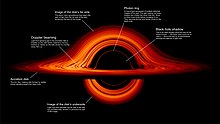
Back Akkresieskyf Afrikaans قرص مزود Arabic Discu d'acrecimientu AST Акрэцыйны дыск Byelorussian Акреционен диск Bulgarian སྣོན་སྡེར། Tibetan Disk uvećanja BS Disc d'acreció Catalan Akreční disk Czech Akkretionsscheibe German

An accretion disk is a structure (often a circumstellar disk) formed by diffuse material[a] in orbital motion around a massive central body. The central body is most frequently a star. Friction, uneven irradiance, magnetohydrodynamic effects, and other forces induce instabilities causing orbiting material in the disk to spiral inward toward the central body. Gravitational and frictional forces compress and raise the temperature of the material, causing the emission of electromagnetic radiation. The frequency range of that radiation depends on the central object's mass. Accretion disks of young stars and protostars radiate in the infrared; those around neutron stars and black holes in the X-ray part of the spectrum. The study of oscillation modes in accretion disks is referred to as diskoseismology.[1][2]
Cite error: There are <ref group=lower-alpha> tags or {{efn}} templates on this page, but the references will not show without a {{reflist|group=lower-alpha}} template or {{notelist}} template (see the help page).
- ^ Nowak, Michael A.; Wagoner, Robert V. (1991). "Diskoseismology: Probing accretion disks. I - Trapped adiabatic oscillations". Astrophysical Journal. 378: 656–664. Bibcode:1991ApJ...378..656N. doi:10.1086/170465.
- ^ Wagoner, Robert V. (2008). "Relativistic and Newtonian diskoseismology". New Astronomy Reviews. 51 (10–12): 828–834. Bibcode:2008NewAR..51..828W. doi:10.1016/j.newar.2008.03.012.